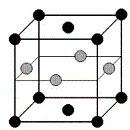Department of Physics and Astronomy: Publications and Other Research

Ralph Skomski Publications
Document Type
Article
Date of this Version
7-2013
Citation
IEEE TRANSACTIONS ON MAGNETICS, VOL. 49, NO. 7, JULY 2013; DOI: 10.1109/TMAG.2013.2244856
Abstract
Nanostructured Mn3-x Ga ribbons with x = 0, 0.4, 0.9 and 1.1 were prepared using arc-melting, melt-spinning and annealing. As-spun samples crystallized into hexagonal D019 and cubic L21 Heusler crystal structures based on the concentration of Mn in Mn3-x Ga. Upon vacuum-annealing the samples at 450°C for about 50 hours, both the hexagonal and cubic structures transformed into a tetragonal D022 structure. High-temperature x-ray diffraction and high-temperature magnetometry showed that the samples with low Mn content (Mn1.9 Ga and Mn2.1 Ga) retain their tetragonal structure up to 850 K but the samples with high Mn concentrations (Mn2.6 Ga and Mn3.0 Ga) undergo a structural phase transition from tetragonal to hexagonal phases around 800 K. The magnetic properties of Mn3-x Ga ribbons were very sensitive to Mn concentration, where the magnetization and anisotropy energy increased and the coercivity decreased as x increased from 0 to 1.1. Although the Curie temperatures of Mn2.6 Ga and Mn3.0 Ga samples could not be determined because of the structural phase transition, the Curie temperature decreased with increasing x in Mn3-xGa. The maximum magnetization of 57 emu/g (300 emu/cm3) and the coercivity of 6.5 kOe were measured in the Mn1.9 Ga and Mn3.0 Ga ribbons, respectively.


Comments
Copyright 2013 IEEE. Used by permission.